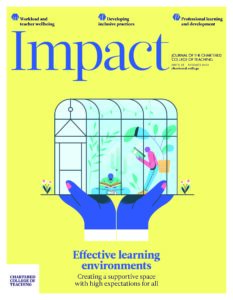The positive outcomes of embedding oracy into the primary setting

Ellen Punter, Teacher, Lecturer; Acting Chair of the English Speaking Union, Ouse Valley Branch, UK
Introduction
‘Children should be seen and not heard.’ This 15th-century proverb was introduced by John Mirk (The Phrase Finder, 2021) and it reappeared, repurposed, during early Victorian times when children were expected to behave like silent little adults. This expression no longer resonates today as parents, from the beginning of a child’s life, talk to their child, listening eagerly for the child to respond. Babies listen first and then engage verbally, commentating on what is around them (Britton, 1974). So why does the emphasis on children’s oracy wane over the years?
This perspective article reflects on some of the historical and current emphases that experts have placed on the importance of teaching oracy in schools, and demonstrates that it is still being redefined and reintroduced today. It examines the outcomes for students when teachers are supported in embedding oracy in primary settings. A case study – research undertaken by Dr. Tony Wood – highlights the effectiveness of working collaboratively and embracing different strategies. The volunteering work by one English-Speaking Union (ESU) Branch shows how this research project continues to have resonance and practical application.
What is oracy? Why is it important in education?
Andrew Wilkinson first introduced the term oracy in 1965 as ‘a condition of learning in all subjects’ – vital in ‘humanising the species’ (Oracy Cambridge, 2019). Since then, there has been no definitive definition for the word ‘oracy’. In April 2021, the All Party Parliamentary Group (APPG) Inquiry, reviewing oracy teaching in schools, saw this ‘as a barrier to advancing oracy education’ (p. 9).
They proposed the following:
‘Oracy is the ability to speak eloquently, to articulate ideas and thoughts, to influence through talking, to collaborate with peers and to express views confidently and appropriately.’ (Oracy All Party Parliamentary Group Inquiry, 2021, p. 9)
The following are pertinent comments on oracy from this report:
- Professor Neil Mercer referred to ‘the art of reasoned discussion’ (p. 14) having positive effects on students’ marks in different subjects, and that oracy is ‘a moral imperative’ (p. 26).
- In the 2014 Code of Practice for students with disabilities and special needs, ‘communication and interaction’ (p. 7) needed curriculum planning attention.
The APPG inquiry (2021) also evidenced the inequality surrounding attainment and the life chances of socially disadvantaged students when they were not explicitly taught oracy in schools. Many of those giving evidence to the inquiry stressed the huge negative impact that this has on the way in which students approach learning, and on their behaviour. The final report made 31 recommendations that, if acted upon, would make oracy core to every curriculum in all educational settings.
The English-Speaking Union, an oracy charity established in 1918, consists of 36 regional branches and is a founder member of the Oracy Network from which the Oracy APPG developed. Its mission is:
‘To give young people the speaking and listening skills and cultural understanding they need to thrive. What can one voice do? We believe it can do anything.’ (The English Speaking Union, 2021)
Dr Tony Wood was a governor of this charity and it is due to his research that the ESU now collaborates with primary as well as secondary schools, to support teachers in embedding oracy. This is achieved by using specific resources to teach students how to structure speeches, summarise information, listen critically to diverse opinions and address different audiences.
Historical discussions on the importance of oracy in education include the Plowden Report (Department of Education and Science, 1967), which followed up on the Haddow Consultative Committee’s report of 1931 and included discussions on how central spoken language was to a child’s learning, enabling the child to express ‘needs, feelings and experiences’ (Lewis, 1963, cited in the Plowden Report, 1967, para. 53). Today, there is renewed emphasis on children’s mental health being prioritised, with adults trying to ensure that children have voices that are heard and responded to, making them feel valued and safe.
The National Curriculum English programmes of study were amended in 2014, stressing the importance of oracy skills:
‘A high-quality education in English will teach pupils to speak… fluently… communicate their ideas and emotions to others, and through… listening, others can communicate with them. … pupils who do not learn to speak… fluently and confidently are effectively disenfranchised.’ (DfEDepartment for Education - a ministerial department responsi... More, 2014, para. 1)
Furthermore, the United Nations Convention on the Rights of the Child (1989) in Article 13 stresses ‘freedom of expression’, while Article 29 emphasises ‘goals of education’, with reference to children ‘fulfilling their potential’ (UNICEF, 2021).
Therefore, over the years, many professional experts have emphatically evidenced why oracy skills are so important for students’ educational outcomes, and the Oracy APPG’s report showed how imperative it is to act now. The repercussions of the isolation and inconsistent education received by students since the beginning of COVID-19 have made this more urgent but, according to OfstedThe Office for Standards in Education, Children’s Services... More, improvements are beginning to be seen in many schools (Ofsted, 2021).
COVID-19 repercussions
The COVID-19 pandemic resulted in lockdowns and restrictions causing massive changes to students’ education, including the need to use new ‘hybrid’ ways of teaching and learning via social media and the internet. Teachers learnt how to video-record lessons and upload them onto websites, and many children logged in from home, joining others learning in the classroom – although seven in 10 teachers thought that online teaching negatively impacted on developing oracy (Oracy All Party Parliamentary Group Inquiry, 2021).
However, it also emphasised the huge digital divide, because many disadvantaged families did not have sufficient technological resources for all members of the family to work or be educated remotely. During this period, many families and schools adapted quickly, although learning and working from home definitely tested the ingenuity, flexibility and resilience of everyone. Subsequently, it was realised how important a structured learning setting was for the students’ wellbeing, attainment levels, cognitive development, reading and vocabulary acquisition.
Recently, Amanda Spielman, Chief Inspector of Ofsted, was positive but cautious about what the inspectors returning to visit schools were seeing: ‘encouraging signs that children are bouncing back’, and teachers ‘making sure [they] understand where children are’ and ‘what’s essential for children to know, so they can get back up to speed’ (2021, para. 10). In the updated education inspection framework, Spielman has redirected her inspectors to look at the effects on the students personally, ‘including their resilience, confidence and independence’, a positive shift in inspection ethos (Ofsted, 2021).
How oracy is being embedded into the primary setting – ESU Ouse Valley Branch case study
Dr Tony Wood, former Vice Chancellor of the Universities of Luton/ Bedfordshire and Chairman of the Ouse Valley (OV) Branch, initiated the Bedfordshire Junior School Public Speaking and Debate Academy Competitions. He undertook research in primary schools in 2010, setting up a research pilot project of speaking and listening activities, developing a resource bank for teachers. These materials could be used either independently or by integrating them into existing areas of the curriculum, with learning objectives outlined.
The project’s emphasis was on improving levels of oracy from an early age, so that these could be developed as the pupils moved through the education system. Over the next four years, these activities were expanded, field-tested with over 3,000 students, revised on the feedback received – such as teachers reporting that they went beyond single oracy lessons into other subjects – grouped into four age bands and then published as a teacher resource book: Speak, Listen and Learn (Wood, 2015).
Research project
A controlled research project with 108 seven- to nine-year-olds, sponsored by the University of Bedfordshire and the ESU, was carried out to empirically examine the effects on school achievement when children:
‘followed a sequence of these activities for a single lesson each week over two terms. Two schools were chosen with contrasting catchments, and matched project and control groups formed in each, using standard educational and social criteria.’ (Wood, 2015, p. 2)
Students were tested and retested seven months apart, using the non-verbal, non-culturally-specific GL Assessment (92 per cent of the children in one of the schools had English as an additional language), and the results were compared to the schools’ National Curriculum interim assessments. The results confirmed that children following the structured programme of speaking and listening activities had, on average, much higher improvements in their tests than expected for their increase in age. ‘Further, these greatly exceeded the comparable gains by the children in the Control Groups who had followed the alternative activities.’ (Wood, 2015, p. 99)
These results are corroborated by the Education Endowment Foundation studies (2011), where their findings also showed that when a sustained oral language programme is delivered over a longer period of time, it may ‘have a high impact on pupil outcomes of six months’ additional progress’ for disadvantaged primary school children.
National Curriculum Key Stage 2 data for all four curriculum areas was compared to the research data, and differences between the project and control groups were again notable, in that ‘the mean scores against targets of the pupils in the programme increased by between 6 per cent and 19 per cent more than the others over the seven months of the project’ (Wood, 2015, p. 99).
The project research results showed that the project group teachers using the oracy activities as prescribed in their primary settings saw positive outcomes on overall school performance and levels of attainment for the project group children. They had developed and enhanced their oracy skills, enabling them to be more confident, learn and retain new material, as well as assess how they learnt – using ‘What went well’ and ‘Even better if’ – when evaluating the activities’ outcomes for themselves (Wood, 2015).
International researchers Akerman and Neale (2011) also corroborate these findings; they examined evidence on the impact and benefits of engaging in debating activities. Their findings suggested that participation can have positive effects on personal factors such as self-confidence, critical thinking and communication skills. They referred to the cross-curricular impact of incorporating debate activities in lessons, citing Jensen (2008), who found that when 10- to 11-year-olds debated, they researched more historical facts and understood different viewpoints.
Ouse Valley Branch (OV) competitions
Following on from Dr Wood’s research, over the last 11 years, thousands of eight- to eleven-year-olds have taken part in annual primary Public Speaking (PS) and Debate Competitions, sponsored by members, with teachers choosing teams of three to represent their schools. Students practise their new-found oracy skills in competitions that serve as targets towards which they can work. These competitions are structured to build self-confidence, self- esteem, critical thinking and practical skills through delivering a speech in front of an audience, listening attentively without interrupting, asking pertinent, relevant questions, rebutting in a debate and developing the ability to work effectively as a team.
In July 2021, the OV Branch trailblazed with the inaugural PS Zoom Competitions; 10 local schools accepted the challenge and tried something completely different, entering only ‘Speakers’ to represent their schools. Parents/guardians and teachers became IT technicians and members learnt new ways in which to judge. All of the children were on video, persuading the audiences with well-researched, passionate speeches on motions such as nuclear weapons, CCTV deterring bullying, fake news and online debt.
Twilight mentoring sessions
Inspirational teachers recognise that they are lifelong learners, reflective practitioners and action researchers. They somehow find the time to listen to their students and other professionals and review/renew their own practice. This is what constructivist theories focus on: ‘discussion, dialogue, the social context of learning and teachers’ ability to scaffold pupils’ learning beyond their current stage of understanding’ (cited in Husbands and Pearce, 2012, p. 7).
The OV branch delivers mentoring sessions for teachers to explore ways of using Dr Wood’s resources, as well as other resources, to introduce the skillsets needed to be taught and practised to develop oracy proficiency; these sessions are structured to be explorative and pedagogic.
Robinson and Taylor (2007, p. 14) stated that ‘student voice work has led to changes in schools… as a result of teachers increasing their understanding of students’ experiences… choosing to change their practice’ (cited in Husbands and Pearce, 2012, p. 3).
Interactive oracy workshops
Prior to the competitions, motivational, interactive workshops are delivered collaboratively with staff in primary settings, enabling students to learn:
- how to examine/evaluate their ideas/opinions and share them with others in a non-judgmental environment
- how to use persuasive language, expansive vocabulary and effective grammar
- how to build self-confidence and critical thinking
- body language, tone/pace of voice, engagement of an audience, listening skills, and asking pertinent and relevant questions
- the importance of teamwork and representing their schools.
Workshop quotes from children
- ‘I first did not want to do it, then I decided to try again.’ (Bedford Road )
- ‘I learnt don’t be scared to give your opinion, the more you speak the more you become confident.’ (Milton Earnest)
- ‘We should not disturb people when they are talking.’ ‘We listened more carefully.’ (St Joseph’s and St Gregory’s RC )
- ‘I am speechless it was so good.’ (Wilden)
Workshop quotes from staff
- ‘The children had the opportunity to take part in a planned mock PS competition and experience how it feels.’ (Fairfield)
- ‘This helped the children to work as a team and build self- confidence.’ (Cauldwell)
- ‘The staff that attended the workshop thought it was fantastic and they implement your ideas into their lessons.’ (St. Joseph’s and St. Gregory’s RC )
Inspirational oracy teachers
Dan Wiltshire, a deputy head, sees engaging with the OV Branch as a ‘cycle of aspiration’, with teachers as coaches. He is ‘sprinkling oracy’ into his school curriculum, using the ‘Speak, Listen and Learn’ framework (Wood, 2015) as part of a three-year plan, inspiring staff from Year 1 to Year 6 to incrementally engage with oracy.
Sarah Stott encourages staff to use this oracy framework as a curriculum ‘thread’. She links motions to concepts being taught; she feels that there is an equity and entitlement regarding access to oracy, linking to pupil voice and empowerment. Teachers can have qualitative conversations with children about what matters to them when discussing motions, giving children ownership of their voices plus the freedom to speak honestly using their points of view.
Conclusion
The positive outcomes of embedding oracy in the primary setting and working in collaboration with others are hugely beneficial holistically for students and teachers. By enhancing their oracy skills, students are ‘seen and heard’ in primary settings by teachers who can then utilise these skills to develop the students’ capacity and enthusiasm to listen effectively, learn new things, retain information, share it appropriately and grow in self-confidence.
Many experts have agreed and evidenced that it is crucially important to nurture and integrate oracy as part of a student’s educational journey. This is vital in an era when the art of oral conversation is often replaced with silent, written conversation.
‘What can one voice do?’ If the user of that voice learns how to use it proficiently, is heard and understood and appreciated for sharing their ideas, no matter what background they come from, then anything is possible.
- Akerman R and Neale I (2011) Debating the evidence: An international review of current situation and perceptions. Research report. CfBT Education Trust. Available at: https://debate.uvm.edu/dcpdf/ESU_Report_debatingtheevidence_FINAL.pdf (accessed 15 March 2022).
- Britton J (1974) Language and Learning. Great Britain: Pelican Books.
- Department for Education (DfE) (2014) National Curriculum in England: English programmes of study. Available at: www.gov.uk/government/publications/national-curriculum-in-england-english-programmes-of-study (accessed 21 October 2021).
- Department of Education and Science (1967) Children and their primary schools: A report of the Central Advisory Council for Education (England). Volume 1: The report. (The Plowden Report.) London: HMSO. Available at: www.educationengland.org.uk/documents/plowden/plowden1967-1.html (accessed 15 March 2022).
- Education Endowment Foundation (2011) Oral language interventions. Available at: www.educationendowmentfoundation.org.uk/education-evidence/teaching-learning-toolkit/oral-language-interventions (accessed 25 February 2022).
- English-Speaking Union (ESU) (2021) Homepage. Available at: www.esu.org (accessed 11 October 2021).
- Husbands C and Pearce J (2012) What makes great pedagogy? Nine claims from research. Research and development network national themes: Theme one. The National College for School Leadership, Schools and Academies. Available at: https://assets.publishing.service.gov.uk/government/uploads/system/uploads/attachment_data/file/329746/what-makes-great-pedagogy-nine-claims-from-research.pdf (accessed 15 March 2022).
- Ofsted (2021) Education inspection framework. Available at: www.gov.uk/government/publications/education-inspection-framework/education-inspection-framework (accessed15 March 2022).
- Oracy All-Party Parliamentary Group (APPG) (2021) Speak for Change: Final report and recommendations from the Oracy All-Party Parliamentary Group Inquiry. Available at: https://oracy.inparliament.uk/sites/oracy.inparliament.uk/files/2021-04/Oracy_APPG_FinalReport_28_04%20%284%29.pdf (accessed15 March 2022).
- Oracy Cambridge (2019) Yeast, not rulers: Oracy, 50 years on… Available at: https://oracycambridge.org/yeast-not-rulers (accessed 11 October 2021).
- Spielman A (2021) Amanda Spielman at the 2021 Schools & Academies Show. Available at: www.gov.uk/government/speeches/amanda-spielman-at-the-2021-schools- (accessed 15 March 2022).
- The Phrase Finder (2021) The meaning and origin of the expression: Children should be seen and not heard. Available at: www.phrases.org.uk/meanings/children-should-be-seen-and-not-heard.html (accessed 15 March 2022).
- UNICEF (2021) How we protect children’s rights with the UN Convention on the Rights of the Child. Available at: www.unicef.org.uk/what-we-do/un-convention-child-rights (accessed 15 March 2022).
- Wood T (2015) Speak, Listen and Learn: Teaching Resources for Ages 7–13. Oxford and New York: Routledge.










